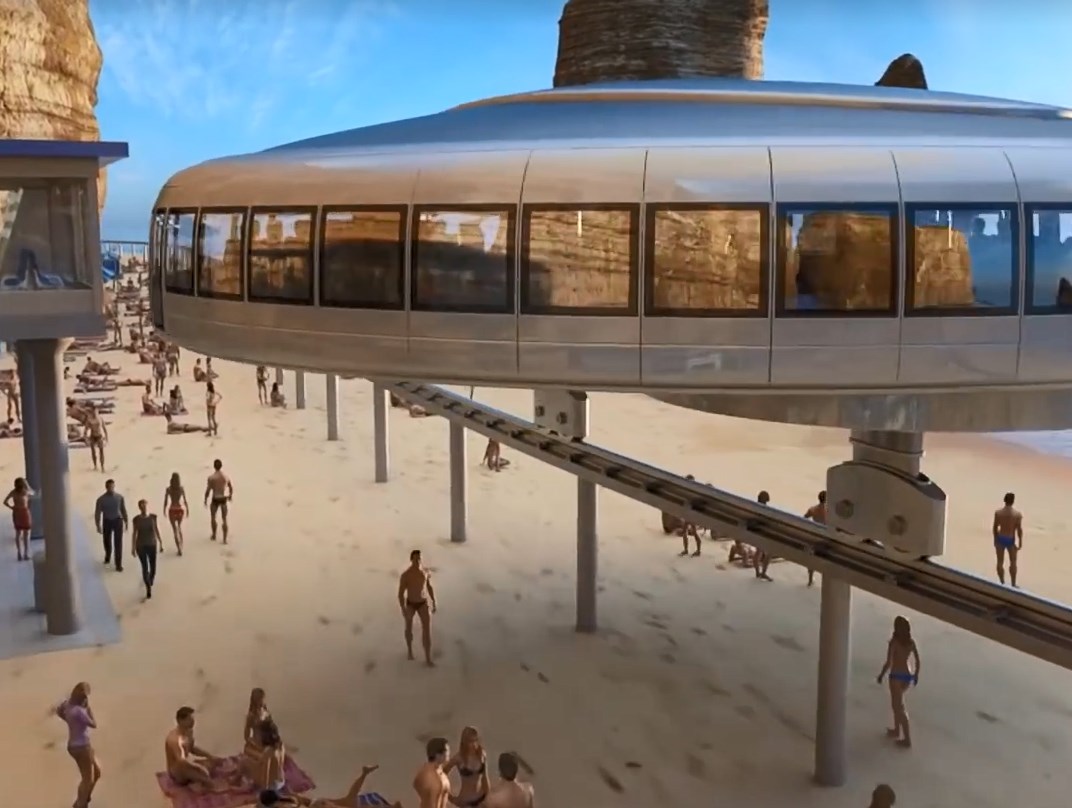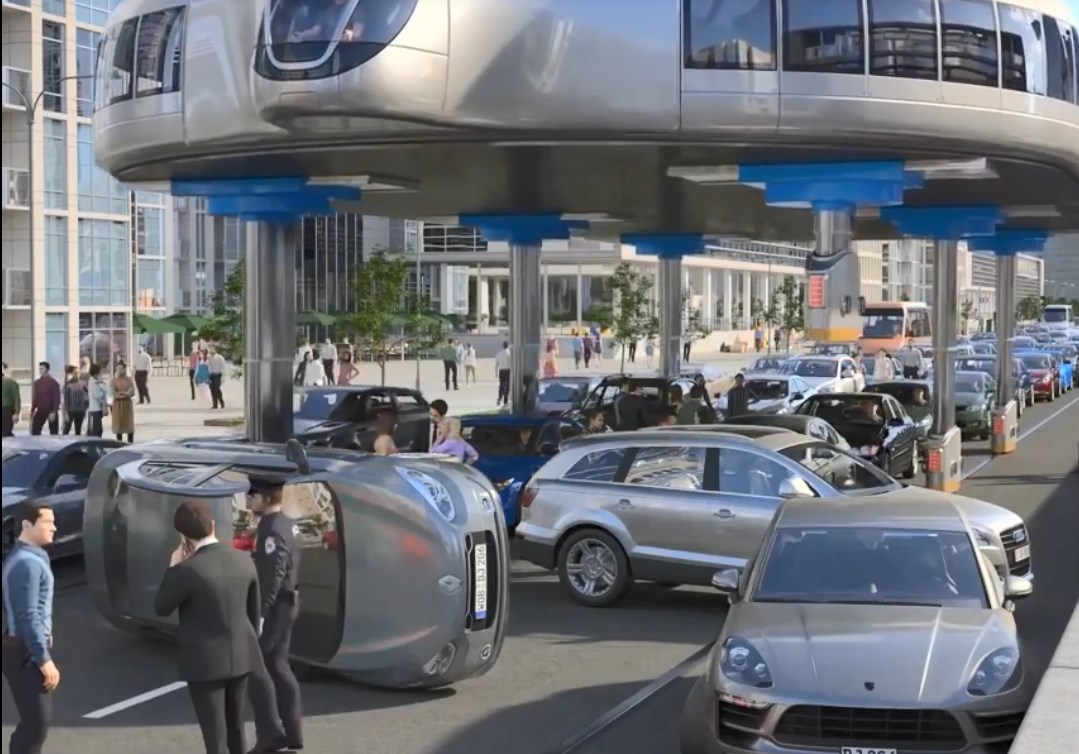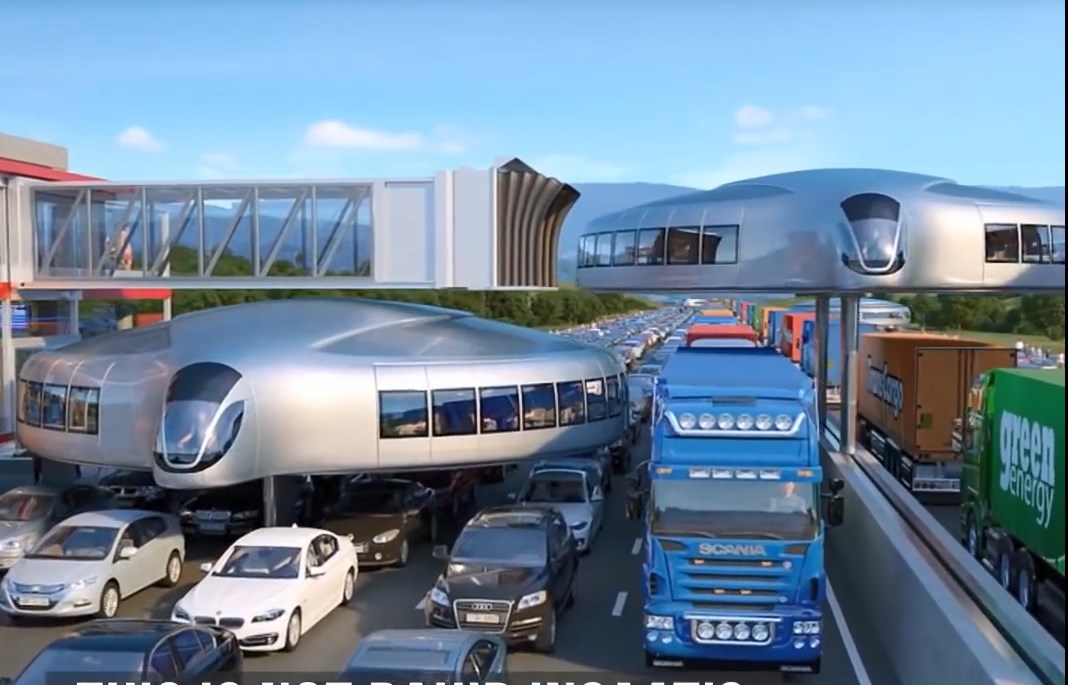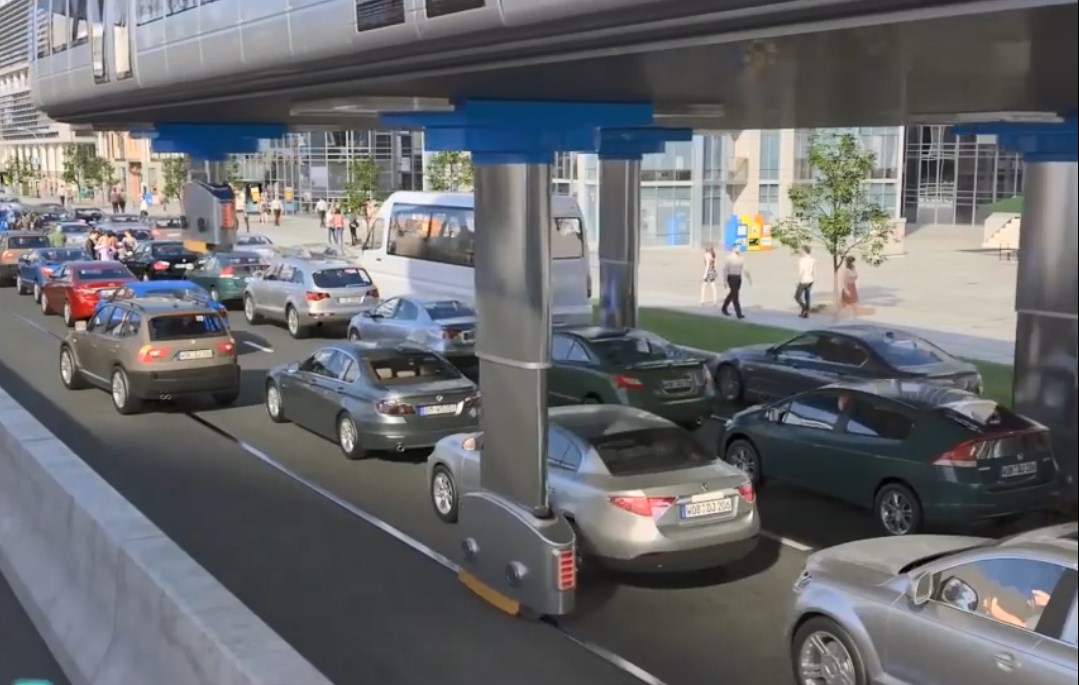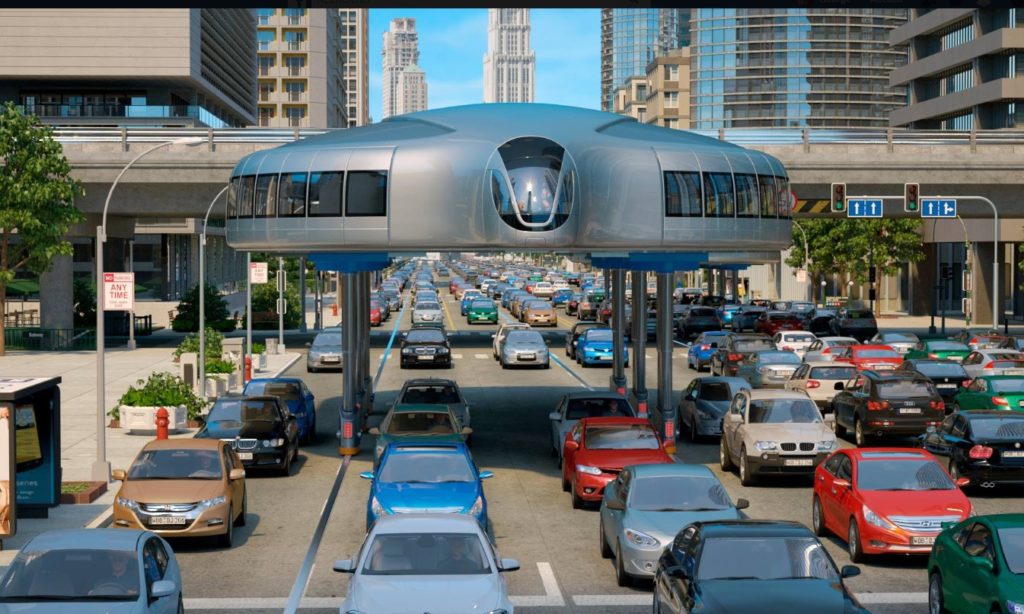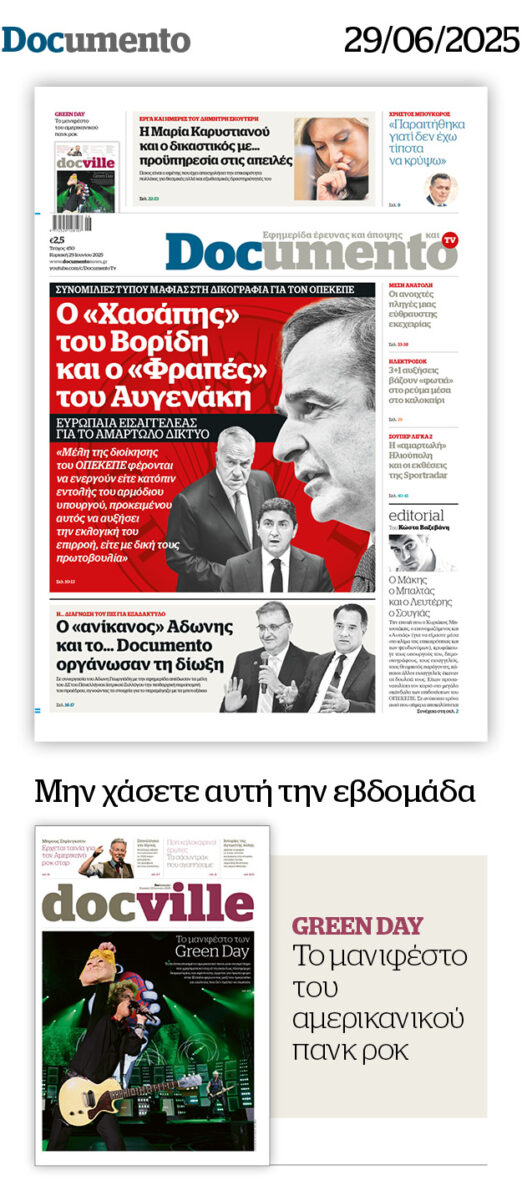Μπορεί να μην έχουμε λύσει βασικά προβλήματα του πλανήτη, όπως το νερό ή τη διατροφή για όλο τον πληθυσμό της Γης, αλλά η ζωή συνεχίζεται και οι σχεδιαστές λύνου προβλήματα άλλου επιπέδου.
Έτσι λοιπόν, μέσα στις προτάσεις για το μέλλον και πέρα από τα ιπτάμενα ταξί και οχήματα, μια εταιρεία – η Dahir insaat – έρχεται να προτείνει τα «λεωφορεία» (Metrobus & ) όπου η καμπίνα βρίσκεται σε απόσταση από το έδαφος και μπορεί να κατέβει σε αυτό στις στάσεις. Αν όμως οι στάσεις είναι ψηλά: κανένα πρόβλημα.
Κινείται με ηλιακή ενέργεια, αφού έχει πάνελ στην οροφή και οι έξι βραχίονες στήριξης είναι ανεξάρτητοι μεταξύ τους. Όταν βρουν εμπόδιο, σηκώνονται για να το υπερπηδήσουν.
Κάτι αντίστοιχο, με λιγότερους βραχίονες προτείνεται για άλλα σημεία, όπως τις παραλίες.
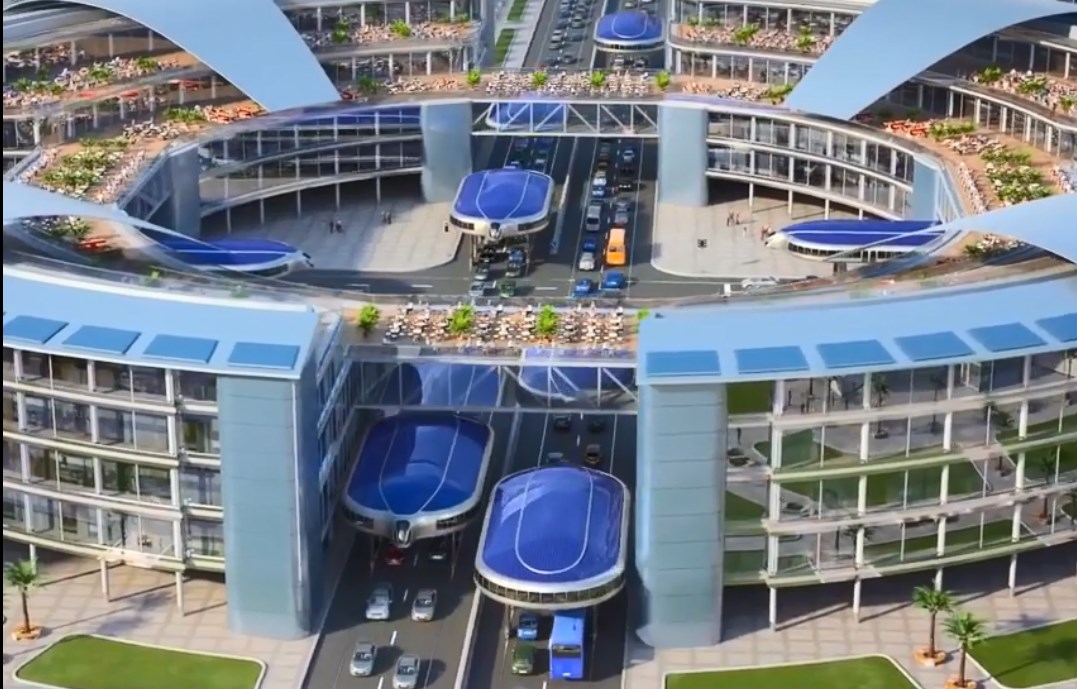
Οι σχεδιαστές σημειώνουν πως η λύση είναι πολύ πιο οικονομική από έναν υπόγειο σιδηρόδρομο.
Το θέμα δεν είναι αν εγκριθεί κάποτε μια ανάλογη λύση, αλλά η φαντασία των επιστημόνων για τις λύσεις στο μέλλον.
Και έχουν φαντασία.
Το βέβαιο είναι πως για κάποιο μελλοντικό κάτοικο της Γης, η σημερινή εποχή μπορεί να μοιάζει με Μεσαίωνα (ίσως και να ‘ναι) …
https://www.facebook.com/WTFuture/videos/458796307922578/UzpfSTEwMDAwMTg2MjM4NTgzNzoyMDg0NTg5NDExNjEzMTE4/
This transport device drives over traffic
Taking public transportation to the next level.
Gepostet von What the Future am Montag, 30. Juli 2018
https://www.facebook.com/Panel.monolit/videos/2041033126180392/
Friends, I am again very pleased to share something with you. Many of you probably remember that four months ago we published the concept for a gyroscopic public transport system, which was welcomed with great enthusiasm by the Internet community. And at the same time, the main theme was the idea that such a system is not possible given the transport industry's current level of technological development, and seemingly every other publication has written about this idea under the headline "transport of the future." And you know, I fully understand them. It's hard for people to imagine such a large object balancing itself on the road. People are not convinced by the example of a desktop prototype. They need to see it in full size. It is for this reason that investors are still cautious. Some realize that it is technically feasible, but they fear that it will not be possible when viewed from the commercial and regulatory angles. And those who are confident that the idea will be a commercial success are afraid that it is not technically feasible. They imagine that all sorts of things could happen with such a devil machine that moves around on two legs. And this is totally understandable. After all, they are not obliged to know to know that everything that is possible in a miniature desktop model is totally feasible on a larger scale. They are not required to know that the larger the mechanism, electric motor or internal combustion engine, the more efficient it is, and thus the greater the overall efficiency of the entire system. Electric motors are more efficient the larger they are. Therefore, the efficiency of electric motors in locomotives exceeds 97%, whereas small radio-controlled toy cars only achieve 75% at most. The same is true for internal combustion engines. On giant ships diesel engine efficiency can reach 55%, whereas domestic lawnmowers only achieve 35% at most. For this reason, the efficiency of transporting cargo in large container ships and freight trains is much higher. The size of a gyroscopic car does not reduce its efficiency in terms of the costs per kilometer to transport passengers. On the contrary, it increases compared with small cars. In other words, the larger the vehicle, the cheaper it is to transport each passenger, ceteris paribus.
After I first posted the film about gyroscopic transport, many insistently requested that I show them how the vehicle was constructed on the inside. In particular, they wanted to know where the gyroscopes, flywheels, batteries, and generators were placed. In response, I am posting the design, which shows the interior of the car and where we intend to install this equipment inside. It matches the design that we patented. Today we already know exactly which companies will be able to supply us with large frameless motors whose stators are 2.7 meters in diameter and gyroscopes with the necessary power. To our delight all of this equipment is already in industrial production and is able to be ordered today.
Our more detailed studies have once again confirmed that a self-balancing vehicle of the dimensions that we depicted in our animated films can be created without deviating at all from the way that it is depicted in the film. I will insist on this design from now on without hesitation or reservations.
In addition, during the course of my work the idea occurred to me of solving this engineering problem in a way that is very simple and can be understood by any person, in a way that can be accurately researched and calculated with the help of today's software products. We have managed to calculate how a vehicle that rests on two supports will be able to stand rigidly upright, and what is the risk of the accident due to the unpredictable behavior of passengers. We were able to calculate the wear of all bearings, wheels, and drives; how long will the service life of the monorail be; how quickly can routine repairs be made on the road; and what will be the operational speed, acceleration, and braking characteristics of the vehicle.
The results turned out to be more than optimistic. Judge for yourself, since I am posting them all in an album devoted to this topic on Facebook. Any engineer can take a look at this data and double check it.The results are as follows:
1. We have engineered a double safety margin for the supports at their most likely point of failure, which is where the leg is linked to the undercarriage below the ground level. This margin provides for a scenario where exactly one half of the car is occupied with people and the other half is completely empty. This is a situation that is hard to imagine occurring in practice. It is one that has been artificially created for reliability calculations. Given normal operating and loading conditions, this safety margin will in fact be fivefold. An automatic system in the car will indicate to passengers using signal lights the seats that they should take in such a sequence that the left and right sides of the car will always be balanced.
Conclusion: People in the car will be as safe as in any tram, bus, or trolley. The gyroscopic cars will not fall over by becoming unstable, under no circumstances, PERIOD.2. All of the critical units of the undercarriage can be manufactured with a high degree of reliability. The rotating bearings, assuming three daily service shifts and an operating speed of 50 km hour, will have a service life of at least ten years. This is a very good value. Note that these parts are serially produced and can be purchased on the open market from the world famous Swedish company SKF.
3. Placing the undercarriage beneath the road surface does not entail any negative factors. The car loses neither maneuverability, speed, maintainability, or service life due to this design decision. On the contrary, it becomes significantly safer. It is able to operate fully electrically and silently. Even when it is one hundred percent loaded, it will accelerate to 50 km per hour in 18 seconds. You will agree that this is fast enough for such a large car. I don't want to repeat myself, but I'll say it again: by being fully electric and noiseless, the vehicle is not only economical and environmentally friendly, but it is also compatible with the human environment in the broadest sense of the word. It is able to accompany the person to every place in the city. Parents will be able to let their children out to play outside without having to fear that their child will be run over by a car. It is impossible for our vehicle to pin anyone down on the ground or to crush them. It is completely safe.
4. The slit in the road may seem to present a problem at first glance, but it can actually be solved without any large expenditures. The opening of the track is not large, as it is just nine cm. An adult wearing shoes will not be able to catch their foot in it, and it also does not present a problem for the wheels of a vehicle or motorcycle. Nevertheless, it can be covered one hundred percent reliably with a special cover made of strong reinforced plastic, which can be easily opened by the vehicle's leg and then immediately closed by behind it. Such a covering will be able to operate very reliably, and it will not cost even one percent of the total energy consumption of the car. The road can be very efficiently and reliably protected from any negligence and even malice. If a foreign object is inserted inside the track, the engineer will learn about it much earlier than many may appreciate, in fact hundreds of meters before reaching the obstacle. The sensors placed inside the track will alert the driver in advance of any such obstructions.
5. Now let us turn to the disadvantages of this mode of transport when compared to the gyrocar that is balanced by flywheels and does not require a deep opening in the roadway (only 15 cm) to create a special solid foundation for the rail. It is clear that in old cities, where the road is filled with utility lines, it will be very expensive to move these lines to accommodate the installation of a monorail in the ground. In this environment a self-balancing gyrocar will be preferred. But in new cities and cities that are currently being designed, this mode of transport can be installed in accordance with the highest quality standards. It will be able to be operated for decades without problems and with only routine repairs. It will last practically forever. We even have the audacity to hope that cities will not be able to call themselves modern or even "smart" if they do not include this mode of transport or something similar.
Conclusion: hundreds of newly designed smart cities will simply be forced to order transportation solutions from us to cover tens of kilometers of their pedestrian streets. Otherwise, their cities will become obsolete even before they are finished being built. How could you argue with that claim?
6. The issue of price. According to our calculations, the cost of such a road will be USD 8–10 million per km, which ensures the very high quality construction of the track, where earn linear meter of reinforced track will weigh almost five tons. Many will struggle to imagine that each linear meter of track accounts for five tons of weight. And yet twenty tons of top-quality concrete will also be required for each meter. Even when constructing the system in such a super-reliable way, it is still 15–20 times cheaper than the cost of building a metro. A metro can cost up to USD 200 million per kilometer. The steel road of our "Metrobus" has a cost that is comparable to a typical European expressway. Information provided for comparison:
The average cost of building 1 km of road in China is USD 2.2 million, USD 6.9 million in the EU, and USD 5.9 million in the US. "In Russia, according to the Federal Target Program, the average cost per kilometer between 2010 and 2015 was USD 17.6 million, whereas in Krasnodar and Novorossiysk the built price was as high as USD 32 million per 1 km. The cost of the Central Ring Road, the so-called "concrete road" (betonka), was USD 40 million. The cost of construction of the Moscow – Petersburg motorway (between the 15th and 58th km) has been USD 65 million." The Western High-Speed Diameter (WHSD) in St. Petersburg cost USD 140 million per km on average; the Moscow Ring Road (MKAD) cost USD 100 million per km; and the Third Ring Road (TTK) cost USD 117 million per km. The cost of building the highway in Sochi was USD 140 million per km.7. In conclusion, I wish to say that we equally believe in the prospects of both modes of transport, including both self-balancing gyrocars and vehicles that operate on monorails that are built into the road. Each has its own specific advantages and is complementary to the other. We very much hope that next year in 2018 we will find a customer who will commission the first kilometers of this mode of transport at the second and third levels. We are confident that this will be a very universal, comfortable, and safe mode of transport. It will be the transport of a civilization that does not engage in wars and conflicts. It will be the transport of happy generations, who will look towards the future of their children with optimism.
Gepostet von Dahir insaat am Dienstag, 26. Dezember 2017
https://www.facebook.com/Panel.monolit/videos/2162154070734963/
Общественный транспорт второго уровня.
Gepostet von Dahir insaat am Donnerstag, 12. Juli 2018
